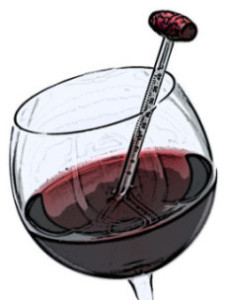It’s A Matter Of Degrees.
Chapter Three, Part Ten.
 Proper wine tasting technique starts with serving wine at the right temperature. Don’t get me wrong. I’m not one of those extremists who bring a wine thermometer to a restaurant and obsess over a few degrees. I’d much rather obsess over something important like who’s picking up the check.
Proper wine tasting technique starts with serving wine at the right temperature. Don’t get me wrong. I’m not one of those extremists who bring a wine thermometer to a restaurant and obsess over a few degrees. I’d much rather obsess over something important like who’s picking up the check.
When wine is served too cold it will exhibit less flavor than one served at room temperature. This is good if the flavors are bad, but it’s bad if the flavors are good. What I’m saying is, cold masks both the quality and the flaws in wine. Studies have shown that people who drink wine too cold become bored and their lives soon lose meaning, usually resulting in heroin abuse or worse, a subscription to People Magazine.
Back in the day, before wine cellars were plugged into an outlet, wine was kept in an unfinished basement. Here, the temperature would gradually change with the seasons, roughly fluctuating between 52 and 62 degrees. Red wines would be brought upstairs before dinner so they could get closer to room temperature, providing the room wasn’t in an igloo. When the wine warmed to about 64 degrees it was time to drink – oh, and eat. Today, most people serve their red wine too warm and their white wine too cold for the wines to behave properly.
So what happens to these misbehaving wines at different temperatures?
I could repeat the age old axiom that red wine should be served at room temperature but I’m not good at lying (which is why I haven’t run for Congress). Aromas and flavors vary depending on serving temperature and there is a range that reveals a wine at its best. For red wine this range  is between 60 and 65 degrees. This temperature wheelhouse is where red wine is the most balanced and serving it outside of this range, either too cold or too hot, can make a perfectly sound wine seem devoid of taste or excessively bitter and alcoholic, just like Nick Nolte.
is between 60 and 65 degrees. This temperature wheelhouse is where red wine is the most balanced and serving it outside of this range, either too cold or too hot, can make a perfectly sound wine seem devoid of taste or excessively bitter and alcoholic, just like Nick Nolte.
I have found that tasting a heavily oaked Chardonnay at different temperatures is like gambling with a 3-card Monte dealer on a Manhattan street corner. Serve it too cold and it will display the acidity card. Perhaps the cold accentuates the acidity, but it’s more likely that it suppresses the fruit and oak flavors so that acidity is all you’re able to detect.
As the wine warms it displays the fruit card. Here the wine is at its most balanced (between 50 and 54 degrees). The edgy acidity recedes as the fruit flavors come forth. The oak, hidden when over-chilled, also begins to surface, mingling with the fruit and acidity in balanced harmony. As Chardonnay warms in your glass it becomes richer, creamier and fuller-bodied. It seems to put on weight faster than a newly married Kardashian.
When the wine reaches room temperature it displays the oak card. The fruit, paramount when the wine was cooler, now begins to lose ground to the emerging oak flavors. Eventually the taste of oak will dominate the flavor profile, once again seeming to throw the wine out of balance.
Most refrigerators are kept around 35 degrees which is fine for yesterday’s tilapia but downright brutal for wine. If you’re serving white wine to your guests for dinner, take it out of the refrigerator about 25 minutes before they arrive so it will warm up to about 45 degrees (plan roughly 4 degrees every 10 minutes). If you let the wine warm as your guests drink it, 25 minutes later they are less likely to notice that they are drinking white wine at 55 degrees. If they are not distracted by your charming personality and witty banter they may notice the wine has evolved with the changing temperature, revealing much more complexity than one served at a constant temperature.
I taste so many white wines at room temperature that I’ve come to like them warmer than my guests. It’s not unusual to find my mother plopping ice cubes into the Corton-Charlemagne I’m serving. I once caught her secretly pouring Sweet and Low into a glass of 1982 Chateau Mouton-Rothschild. It has been rumored that on the same day Baron Philippe de Rothschild apparently turned over in his grave.




















